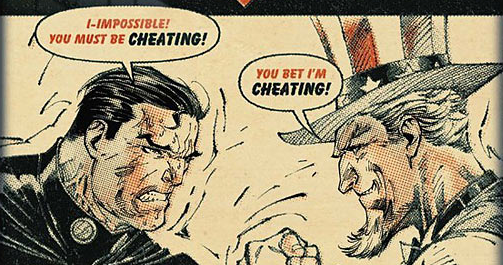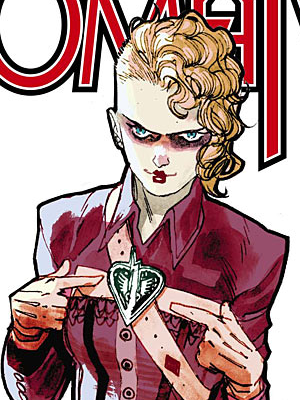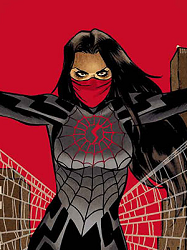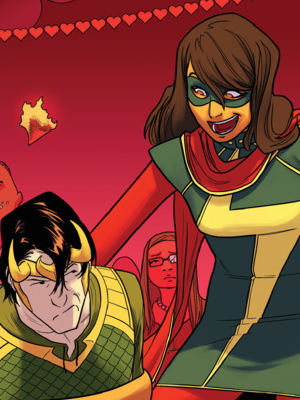Deadshirt Is Reading… is a weekly feature in which Deadshirt’s staff, contributing writers, and friends-of-the-site offer their thoughts on Big Two cape titles, creator-owned books, webcomics and more. For more of our thoughts on this week’s new comics, take a look at Wednesday’s Deadshirt Comics Shopping List.
Dom, Jason, David, and Joe are Reading…
In this month’s Multiversity Roundtable, Deadshirters Dominic Griffin, Jason Urbanciz, David Uzumeri, and Joe Stando fine-tuned their vibrational frequencies and shared their impressions of the installment out this week.
The Multiversity: The Mastermen #1
Written by Grant Morrison
Pencils by Jim Lee
Inks by Scott Williams, Sandra Hope, Mark Irwin and Jonathan Glapion
Colors by Alex Sinclair and Jeromy Cox
DC Comics
The latest issue of The Multiversity reads somewhat disappointingly like a regular Elseworlds story, but there’s something bubbling beneath the surface that might elevate its standing against other issues on subsequent rereads. Principally a blatant counter-take to Mark Millar’s Superman: Red Son, The Mastermen follows a Superman who was discovered by Hitler instead of Ma and Pa Kent, which feels pedestrian as a premise compared to the stories Grant has treated us to thus far. It flashes forward to a world where Nazi-run America and its cracked mirror Justice League have both made peace with their horrific genocidal past, but Overman’s conscience gnaws at him nightly. It’s an interesting tale, but its abrupt, open-ended conclusion leaves more on the table than any of the previous issues, which hopefully means the final issue will pick up some of its dangling threads. Unfortunately, it feels incomplete, not in the “leaves you wanting more” way but more like “no, wait, seriously, that’s it?”
Jim Lee was an inspired if ill-suited choice to draw The Mastermen. On paper, it seems as if Grant had written the screenplay to something as meditative and harrowing as The Pianist, but cast Michael Bay to direct in Roman Polanski’s stead. The results are fascinating, as Lee’s recognizable superheroics and iconography are overtly subverted, but you can’t help but feel a more subtle hand would have executed some of the story’s beats more eloquently, rather than leaving the pathos and power to the reader to infer.
– Dominic Griffin
When I saw that Jim Lee was scheduled to draw this issue of The Multiversity, I immediately had a bad feeling about it. Besides not being one of my favorite artists, he just didn’t seem to fit the material as well as all of the other artists did (my personal pick for this issue would have been Jerry Ordway). It felt like a compromise, and ultimately this issue feels like the first of the series to miss its mark. It takes place on Earth-10 (a.k.a. Earth X), a world where Kal-El landed in Europe in 1945 and was raised by Hitler to dominate the world. The story picks up sixty years later, where Overman rules the world, but regrets his past. In that regret lies what feels like another compromise: in order to make us sympathize with him, Morrison gives him a pass on the genocide of Hitler and shows that it haunts him. If you’re gonna use Nazi Superman you’d better commit, and this feels like he pulled back. From there, the story is pretty muddled. Overman, mourning the death of his cousin, Overgirl (back in Final Crisis), is confronted by the still-living spirit of America in Uncle Sam, who is now making terrorist attacks against his rule. We meet the Nazi Justice League and Uncle Sam’s Freedom Fighters, but neither group gets much more than an introduction. While most of the issues so far of The Multiversity have felt like first issues, this felt more like a zero issue, a quick taste to give you the concept but without much story heft. Just when the book feels like it’s set up everything and put the plot into motion, it’s over. It also doesn’t seem to have that much to do with The Multiversity as a whole. We see one of the The Gentry (Lord Broken) haunting Overman’s nightmare, and he may be using him as a tool in tearing his world apart, but it feels like there are pages missing that would have given the story a lot more clarity.
I’m not a big fan of Jim Lee, but I do appreciate his art when he’s on his game, and here it’s pretty rough. You can definitely see the amount of detail decrease with each page, and the final few look really, well, sketchy. It can’t help that he had four different inkers working with him; I’d imagine the best pages of the book were handled by Scott Williams, his usual inker. But for a series that has been defined by perfect art so far, this one is a letdown.
While this issue didn’t deal a serious blow to The Multiversity overall, it’s definitely the first real disappointment for me. It did have some interesting story beats, but at the end it left them all dangling, and I’m not crying out for any of them to be picked up.
– Jason Urbanciz
This is easily the most disappointing of the lot so far, treading over well-worn ground with a lack of nuance uncharacteristic for Morrison (although sadly characteristic for Lee). It’s difficult not to draw comparisons between this and Superman: Red Son, by Morrison’s former protégé Mark Millar with artists Dave Johnson and Kilian Plunkett, which featured a similar conceit of “what if Kal-El landed in <country of America’s enemies> and somehow magically the rest of the Justice League showed up there too?” While Red Son had the advantage of being a three-part prestige format miniseries rather than a 40-page special, it’s difficult not to feel like the requirement of brevity hampers it more than it should, considering the way Morrison’s worked within it for the rest of this series. While Overman’s concept, and his overwhelming guilt, are well-executed, they aren’t expanded on much past the single panel in Final Crisis: Superman Beyond, where he stated his basic concept to the incredulous Billy Batson of Earth-5. Uncle Sam is basically a cipher, and outside of the Human Bomb, his United Freedom Fighters of Benetton appear for only a single splash page.
The real downer here, though, is Jim Lee, whose art is still perpetually stuck in 2002. When Overman hits the same hand-on-knee pose Superman rocked on the first cover of “For Tomorrow” in Superman v2 #204, it’s hard not to be struck by just how little Lee’s art has changed since his big return to superhero comics with “Hush,” and the ongoing, practically permanent collaboration with Scott Williams and Alex Sinclair doesn’t help. These are all talented artists in their own right, but I’d highly recommend that the members of this artistic marriage head to a swingers’ club and fuck other people for a while. Sinclair’s a great colorist, and has flexed his muscles with artists as diverse as Doug Mahnke and Frank Quitely, but these three have become almost too much of a well-oiled machine, without the spark of creativity and madness that’s accompanied, well, every other issue of The Multiversity.
Is it a bad comic? God no, it’s still Grant Morrison and Jim Lee telling a 40-page depressing-ass story about Nazi Superman being really sad that he runs a utopia built on the bodies of millions. These dudes are still talented, even when they’re going through the motions. But it’s hard not to compare it, narratively, to Society of Super-Heroes, where Morrison and Sprouse used a similar structure (diarized by a character at a point in time beyond the events of the issue) but it felt far more fresh and satisfying, with the individual elements still coalescing and converging by the end of the issue. Here, in contrast, a number of plot threads and pieces just feel…unresolved. It’s not a one-shot that could lead to more, it’s a #0 issue without the ongoing series that could follow.
– David Uzumeri
Like a lot of people I’ve talked to, I was initially disappointed with Mastermen, but going back and rereading it has let it grow on me a little bit. There’s a lot of individual beats that are great, from opening with Hitler on the can to the little bit of the Freedom Fighters we do get to see. More than anything, though, I loved the guilt that Overman deals with, in the context of a universe where the Nazis won and the war is far enough in the past that they feel safe in admitting some of their atrocities. This little twist elevates it about a mere “superheroes are evil/Nazis won the war” story and makes it troublingly relevant for the reader. How many times have pundits or acquaintances on social media made similar statements to Leatherwing’s: “That happened decades ago, before I was born.” Adding the element of Uncle Sam as an actual terrorist with an enormous body count in this issue alone, it’s hard not to see the criticisms of the U.S. being leveled. Like everyone else has said, though, this issue’s biggest flaw is that it feels more than anything like a prologue to something we’ll never read. I’d love a little bit more of this to digest and unpack, but as it is, Mastermen was probably the scantiest issue so far.
– Joe Stando
Sarah Register is reading…
Written by Marc Andreyko
Pencils by Georges Jeanty
Ink by Karl Story and Dexter Vines
Color by Guy Major
Letters by Todd Klein
DC Comics
“Don’t worry. I’m not here to kill you.”
I have a fondness for weird characters, and Marc Andreyko has blessed us with an entire team of them. The Unknowns (Batwoman, Red Alice, Etrigan, Ragman, and Clayface) arc began in issue #35 with a demon battle in space, and the story has since been backtracking to explain what the heck is happening. This particular installment got a little slogged down jumping from character to character as all the pieces fell into place, but now that the setup is complete, the story should get explosive in the next issue.
Georges Jeanty’s artwork, so synonymous in my head with the Buffy comics, works really well with the fantastical for the simple reason that his characters emote so clearly, even when that character is an amorphous blob of mud. It balances out the supernatural with the real, and brings the antiheroes who are really “out there” down to a relatable level. This coincides with Andreyko humanizing the clay creatures, vampires, and yellow demons that have infiltrated Batwoman’s side of Gotham. I was biased from the get-go on this team-up because Etrigan and Ragman are some of my favorites in DC Comics, but the dynamic that has been created throughout the group is quite convincing as well. Even Clayface has become a completely new character (after a memory wipe), going from gruff Arkham escapee to a lovable mope seeking penance.
For a title as wrought with controversy as Batwoman, after her non-marriage and losing an entire creative team, this has been an enjoyable and, at least for me, nostalgic story arc which will unfortunately end the series as Convergence takes over the DCU. I hope this doesn’t mean the end for the Unknowns, because there’s so much more to be explored through these characters and their relationships with each other. The final two issues (or more accurately, a final issue plus an annual) should be incredibly fun, as this ragtag group of weirdos faces off with a super-powered Morgain le Fay and her demon horde.
Joe Stando is reading…
Written by Robbie Thompson
Pencils and Inks by Stacey Lee
Colors by Ian Herring
Letters by Travis Lanham
Marvel
“Um… crime doesn’t pay!!”
Cindy Moon, a.k.a. Silk, is a character created by Dan Slott in the beginning of the most recent run on Amazing Spider-Man. She’s a superhuman, empowered by a bite from the same spider as Peter Parker, although her power set is slightly different. She was locked away in a bunker to protect her from the Inheritors (Spider-Verse bad guys), but now she’s out and eager to make up for lost time as a heroine. Due to the nature of their powers, she also possesses a link to Peter Parker, an element of which is a “pheromone-based attraction.” It’s this last point that really turned me off to the character, as Slott consistently presented her and Spider-Man in a sort of skeevy, questionable light. Most of her dialogue in the second issue of Spider-Verse is characterized by her interest in hooking up with Peter Parker, and whether she feels that way towards any other parallel universe Spideys. It was gross, it turned me off to the character, and I was wary of this book.
Well, I’m happy to report that Silk #1 is everything good about the character, and none of the bad. Thompson places the focus squarely on Cindy in her own context, rather than as a sidekick to Spider-Man. There’s plenty there to work with, as she’s a smart, pro-active person who was essentially released from a ten year captivity. The time away from others clearly weighs on her, as she’s torn between trying to make friends and strike out on her own, and going back to the solitude she’s grown used to. There’s some long-term arcs being set up, from the mystery of her parents, who disappeared after she went into the bunker, to a rivalry with Black Cat. Overall, though, it feels like a very natural snapshot of the character’s life and her conflicts, both with villains and internal.
Stacey Lee’s art is also gorgeous here, you guys. It’s the right level of stylization that really makes the Silk design pop, which was an issues under some of the more ink-heavy artists of Spider-Verse. Clean lines, simple but deceptively powerful facial expressions and body language, the whole nine yards. Herring’s bold palette brings the book even more life, like a Saturday morning cartoon (and I love Saturday morning cartoons).
Even the core issue I had with the character, her relationship with Spider-Man, is recontextualized beautifully. Silk is still someone just starting out in the world, barely keeping it together. Her vulnerability around Spider-Man is confusing, and she has a lot of trouble handling it. For his part, Parker wants to help, but doesn’t really seem to get how to be there for her in a reliable, platonic way. It’s a much more relatable, complex dynamic, and I hope any and all other Spider-writers take cues from Thompson. This book joins Batgirl and Unbeatable Squirrel Girl in the growing trend of books about developed, realized female leads on their own terms, and Big Two comics are better for it.
Patrick Stinson is reading…
Written by G. Willow Wilson
Pencils and Inks by Elmo Bondoc
Colors by Ian Herring
Lettered by Joe Caramanga
Marvel
“They’re coming, man. Gentrification. Next year it’ll be Viking dudes from here to Newark Ave.”
Ms. Marvel has been a delightful monthly blessing for a year now—the first cape book I’ve ever followed from the start. I have no desire to stop, but this issue, a one-shot Valentine’s Day romp, reminded me what a mixed blessing superhero books can sometimes be.
The elements of the story that tie into the ongoing plot are great, if a little low key. The regular characters, Kamala Khan and her friend/sidekick/mentor Bruno, are getting a bit of a breather. With the first major arc wrapped up, Bruno has time to process his growing romantic feelings for Kamala. This is going to be a problem for all kinds of reasons, given their current relationship and Kamala’s strict, religious parents.
Bruno’s budding feelings are given a prod by Loki, who’s given a paper-thin excuse to go be an agent of Asgard over in Jersey. He divides his time between half-heartedly trying to gather intelligence on Kamala’s foe the Inventor and just messing with people for his own amusement. He prods Bruno into sending her an anonymous love letter (protip from someone who did this in high school: never do this). Kamala shows up at the big dance to spy on her ostensible suitor, only to see Loki at the gym and suit up to try and deal with him.
It’s not a bad farce, but the impact that tangling with Loki ought to have on a rookie superhero like Kamala is way underplayed for the sake of the comedy of the story. Yeah, Loki is sort of a good guy now, but to someone like Kamala (a fangirl for half the Avengers but who had never heard of an Inhuman) you’d think that this particular Asgardian showing up at your high school would be deeply terrifying. It’s good issue with a lot of quality wit and character work, but the crossover mechanics just didn’t quite work for me.
Thanks for reading about what we’re reading! We’ll be back next week with a slew of suggestions from across the comics spectrum. In the meantime, what are you reading? Tell us in the comments section, on Twitter or on our Facebook Page!






